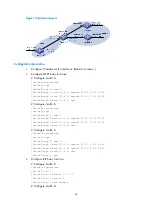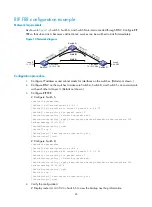
30
Step Command
Remarks
3.
Configure the filtering of
incoming routes.
filter-policy
{
acl-number
|
gateway
ip-prefix-name
|
ip-prefix
ip-prefix-name
[
gateway
ip-prefix-name
] }
import
[
interface-type interface-number
]
Not configured by default.
The
filter-policy import
command
filters incoming routes. Routes not
passing the filtering will be neither
installed into the routing table nor
advertised to neighbors.
4.
Configure the filtering of
outgoing routes.
filter-policy
{
acl-number
|
ip-prefix
ip-prefix-name
}
export
[
protocol
[
process-id
] |
interface-type interface-number
]
Not configured by default.
The
filter-policy export
command
filters outgoing routes, including
routes redistributed with the
import-route
command.
Configuring a priority for RIP
Multiple IGP protocols can run in a router. If you want RIP routes to have a higher priority than those
learned by other routing protocols, then assign RIP a smaller priority value to influence optimal route
selection.
To configure a priority for RIP:
Step Command
Remarks
1.
Enter system view.
system-view
N/A
2.
Enter RIP view.
rip
[
process-id
] [
vpn-instance
vpn-instance-name
]
N/A
3.
Configure a priority for RIP.
preference
[
route-policy
route-policy-name
]
value
Optional.
100 by default.
Configuring RIP route redistribution
If a router runs RIP and other routing protocols, you can configure RIP to redistribute OSPF, IS-IS, BGP,
static, or direct routes.
Only active routes can be redistributed. To display route state information, use the
display ip
routing-table
protocol
command.
To configure RIP route redistribution:
Step Command
Remarks
1.
Enter system view.
system-view
N/A
2.
Enter RIP view.
rip
[
process-id
] [
vpn-instance
vpn-instance-name
]
N/A
3.
Configure a default metric for
redistributed routes.
default cost
value
Optional.
The default metric of a redistributed
route is 0.






























